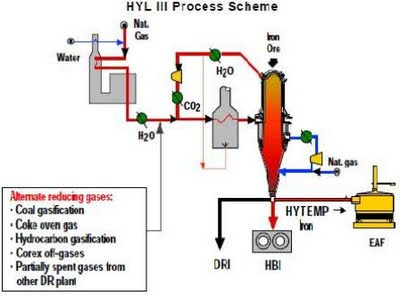COREX Process and Technology of Ironmaking
The COREX technology is a cost efficient, environmentally friendly and industrially accomplished alternative to
the blast furnace route for the production of hot metal from iron ore
and coal. By fulfilling more stringent
ecological regulations by law, utilization of low-cost, highly available low
grade raw materials including fines, the COREX process has been accepted as a commercially
proven technology for present and future iron making process. The
COREX process was created by Siemens VAI and was elevated to
industrial maturity by PRIMETALS. Primetals Technologies Limited, is a London (UK) based engineering and plant
construction company established in 2015 by a joint venture of Siemens VAI
Metals Technologies and Japan’s Mitsubishi Hitachi Metals Machinery (MHMM).
In
a nutshell, COREX is a coal based SR (smelting reduction) process of making hot
metal or pig iron by direct use of non-coking coal. The outputs can be used
either by integrated mills or EAF (electric arc furnace) mills. The process
gasifies non-coking coal in a smelting reactor, which also produces liquid
iron. The gasified coal is then fed into a shaft furnace to remove oxygen from
iron ore lumps, pellets or sinter and finally, this direct reduced iron (DRI)
is fed to the smelting reactor. Compared with the traditional iron making
process via the blast furnace route, the COREX process differs since non coking
coal can be directly used for ore reduction and melting work, eliminating the
need for coking plants. The use of lump ore or pellets also dispenses with the
need for sinter plants.
Some
Merits and Demerits of COREX Process
=>
Conducive to production of high end and special steel required for
sophisticated industrial and scientific applications with minimum damage to the
environment at various stages of steel making and mining.
=>
Unlike the conventional Blast furnace route for production of hot metal, it can
accept high alkali containing ores without any build up inside the reactor.
=>
It takes only half an hour to stop the plant and only four hours to restart it.
=>
Specific melting capacity is higher than that in Blast Furnace; productivity
around 3.5 t/m3/d can be achieved.
=>
In 2009 Siemens first completed a life cycle assessment for pig iron
production, looking at both conventional production in a blast furnace and the
more environmentally friendly COREX and FINEX processes. Siemens claimed the
COREX and FINEX processes can substantially reduce pollutant emissions when
compared to traditional steel production, with its blast furnace and coking and
sintering facilities.
=>
The iron content of the feed should not be less than 50% as otherwise the slag
volume produced will be too high.
=>
As is the case in blast furnaces, over 90% of the phosphorous input reports to
the hot metal. So, the phosphorous content of ore and coal should be as low as
possible.
=>
There are also reports that the COREX process cannot be operated without some
amount of coke along with non-coking coal - at least around 10% of coke is
required in the total reductant charge.
=>
As far as coal is concerned, the non-coking coals having too high volatile matter
(VM) or too low fixed carbon (FC) cannot be used in corex process of iron making.
=>
The heat transfer plays a crucial role in the overall efficiency of the COREX
process. This being a two stage process, i.e. reduction and smelting taking
place in two separate units, post combustion of the gas generated in the
smelting unit provides the heat to melt the DRI produced in the reduction unit.
This calls for high heat transfer efficiency.
=>
Unless the net export gas from any Corex plant (extent of generation around
1650 Nm3/thm) can be utilized, the process will not be economical.
Because of many peripheral requirements, the total cost of a Corex project can
be relatively high.
=>
The export gas generated in Corex
technology can be used as a fuel gas in the downstream facilities to generate
electricity or for the production of direct reduced iron in a region that has
almost no resources of natural gas.
=>
COREX plant emissions contain only insignificant amounts of NOx, SO2, dust,
phenols, sulphides, and ammonium. Emission values are already far below the
maximum values allowed by future standards. Also, waste-water emissions from
the COREX process are far lower than those in the conventional blast-furnace
route. These environmental features are key reasons for the attractiveness of
the COREX process.
Related Articles










